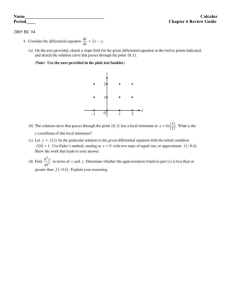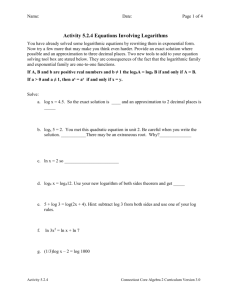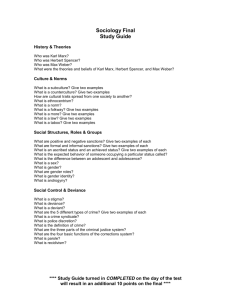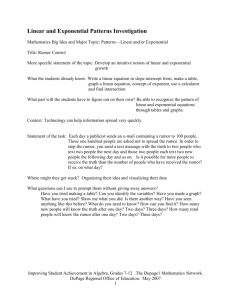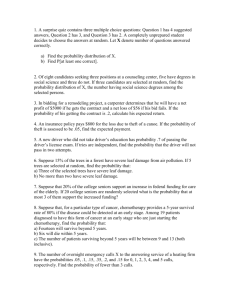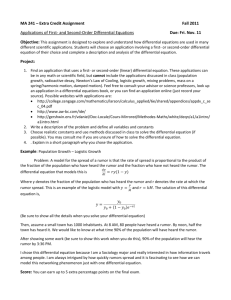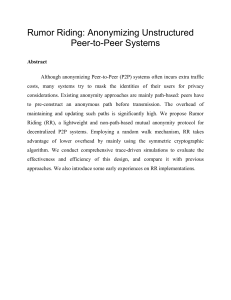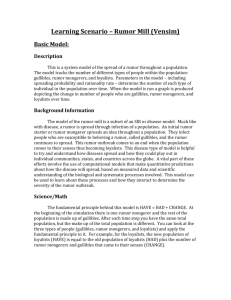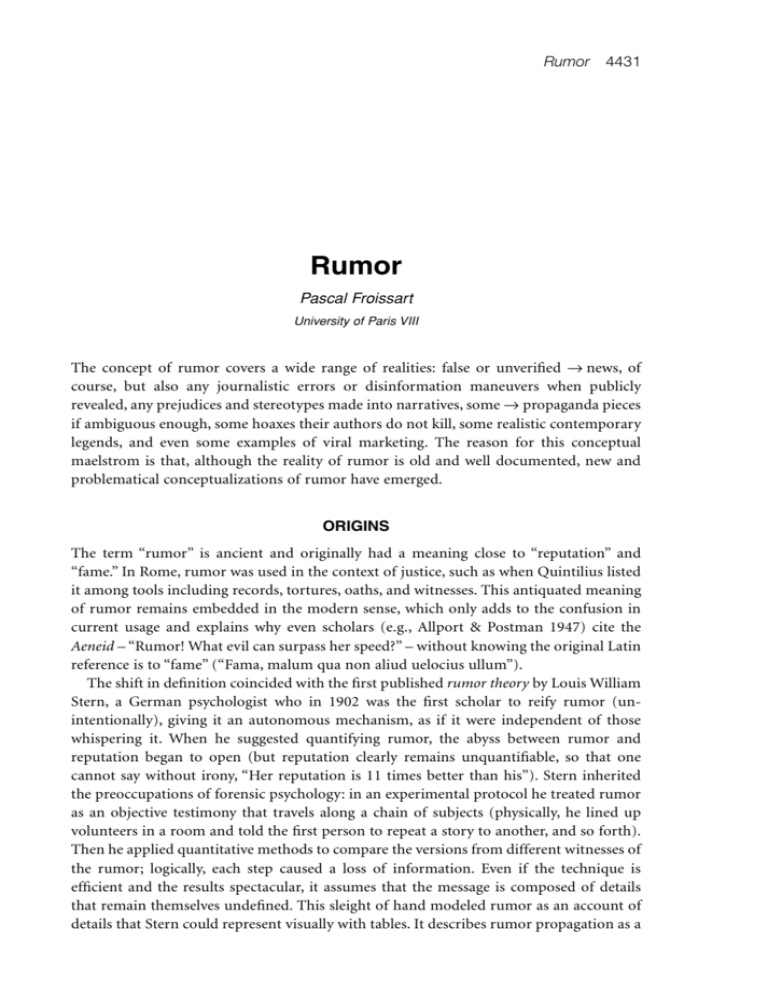
Rumor 4431
Rumor
Pascal Froissart
University of Paris VIII
The concept of rumor covers a wide range of realities: false or unverified → news, of
course, but also any journalistic errors or disinformation maneuvers when publicly
revealed, any prejudices and stereotypes made into narratives, some → propaganda pieces
if ambiguous enough, some hoaxes their authors do not kill, some realistic contemporary
legends, and even some examples of viral marketing. The reason for this conceptual
maelstrom is that, although the reality of rumor is old and well documented, new and
problematical conceptualizations of rumor have emerged.
ORIGINS
The term “rumor” is ancient and originally had a meaning close to “reputation” and
“fame.” In Rome, rumor was used in the context of justice, such as when Quintilius listed
it among tools including records, tortures, oaths, and witnesses. This antiquated meaning
of rumor remains embedded in the modern sense, which only adds to the confusion in
current usage and explains why even scholars (e.g., Allport & Postman 1947) cite the
Aeneid – “Rumor! What evil can surpass her speed?” – without knowing the original Latin
reference is to “fame” (“Fama, malum qua non aliud uelocius ullum”).
The shift in definition coincided with the first published rumor theory by Louis William
Stern, a German psychologist who in 1902 was the first scholar to reify rumor (unintentionally), giving it an autonomous mechanism, as if it were independent of those
whispering it. When he suggested quantifying rumor, the abyss between rumor and
reputation began to open (but reputation clearly remains unquantifiable, so that one
cannot say without irony, “Her reputation is 11 times better than his”). Stern inherited
the preoccupations of forensic psychology: in an experimental protocol he treated rumor
as an objective testimony that travels along a chain of subjects (physically, he lined up
volunteers in a room and told the first person to repeat a story to another, and so forth).
Then he applied quantitative methods to compare the versions from different witnesses of
the rumor; logically, each step caused a loss of information. Even if the technique is
efficient and the results spectacular, it assumes that the message is composed of details
that remain themselves undefined. This sleight of hand modeled rumor as an account of
details that Stern could represent visually with tables. It describes rumor propagation as a
4432 Rumor
message diffusing by itself, traveling toward the worst, coming from truth and becoming
false.
The new sense of rumor spread slowly. In 1911, one of Stern’s colleagues, Rosa
Oppenheim, was the first to link rumor and the press. She writes about her surprise upon
observing that newspapers can print unverified or bad information and wonders why
refutations are slow to arrive and then go unnoticed (→ Objectivity in Reporting;
Journalism). Around the same time, the psychoanalyst Carl G. Jung, Stern’s Swiss
correspondent, published a brief article reporting his study of the diffusion of a rumor in
a classroom. More than the telling of a good story, Jung concluded, the girls shared
“etiologic conditions,” a way to suppose the existence of a collective unconscious and to
interpret details as symptoms of a deeper trouble. Oppenheim and Jung’s heritage is a
burden: all of the media must struggle against popular falsehood, that is, rumor, and all
rumors are suspected of carrying a second message to decipher.
THE MODERN CONCEPT OF RUMOR
However, the canonic model of rumor diffusion was still to come. One of the touchstones
of the modern concept is diffusion control, and its father is Gordon Allport, a former
student of Stern and one of the most prominent social psychologists in the United States.
When World War II began, the army engaged Allport officially in monitoring and enhancing
American civilian morale. He proposed using rumor as a thermometer. The hidden goal
was to monitor the penetration of propaganda the enemy broadcast over short-wave
radio (Kishler et al. 1968). Allport also created rumor clinics, with civilians, police
officers, and war correspondents in charge of debunking rumors and Nazi propaganda
and publishing the official results in the syndicated columns of the biggest newspapers in
the country (→ Propaganda in World War II). Rumors became identified as enemy
matter.
After the war, Allport and one of his Harvard colleagues, Leo Postman, published two
articles that met with instant success, even if some of their findings are highly
questionable (Allport & Postman 1947). For example, they assert a basic law of rumor (R
~ i × a), where the quantity of rumors in circulation (R) depends on the importance of
the news (i) and the ambiguity of the evidence (a), a formulation of common sense at
once alarming for its positivism and impossible to measure for any of its proposed terms.
Following the same tack, they propose a generalization of the rumor formula capable of
describing a basic course of distortion: rumors travel, they say, with three biases – leveling,
sharpening, and assimilation – losing most of their details, recomposing themselves from
only certain aspects, and associating their meanings with pre-existing prejudices and
stereotypes. If these mechanisms were obvious in the laboratory (the book includes 17
extensive experiments; → Experiment, Laboratory), they have become obsolete in life.
Some of the most important rumors, like the 1969 report that Paul McCartney of the
Beatles pop group was secretly dead, behaved nothing like what Allport and Postman
described (Rosnow 1991). Even the endeavors to see rumor as an alternative mode of
communication, in Africa in particular, tend to demonstrate the contrary (Ekambo 1985).
If rumors diffuse among informal and auxiliary channels, such as word of mouth,
clubs, or other circles (Shibutani 1966; → Communication Networks; Organizational
Rumor 4433
Communication), they travel as well among formal ones, such as media and official
statements, which may have more effect on audiences. Research focuses on informal
channels and cognitive factors, because these resemble the popular idea of rumor. But
rare → case studies do show the importance of media, the most-quoted source of rumor
(Kapferer 1989; → Risk Communication). The media, and journalists particularly, diffuse
rumors on four types of occasions: when they are abused by rumor; when they try to
refute it; when they do special coverage of rumors; or when rumors play a part in movies
or television scenarios (→ Fictional Media Content).
Folklorists and ethnologists have led the latest evolution in rumor research during the
last 30 years. To the idea of rumor as a diffusion process, they add that extensive
traditional and cultural background is necessary for the hearer to understand a rumor
(→ Storytelling and Narration; Suspension of Disbelief; Popular Communication).
Contemporary legends often share narrative characteristics with rumors. Rumor studies,
which emerged at the beginning of the twentieth century, have grown more complex,
including research fields other than law or journalism.
SEE ALSO: Case Studies Communication Apprehension and Social Anxiety
Communication Networks Culture and Communication, Ethnographic Perspectives on Diffusion of Information and Innovation Disasters and Communication
Discourse, Cognitive Approaches to Experiment, Laboratory Fictional Media
Content Journalism Memory, Person News Objectivity in Reporting Organizational Communication Perceived Reality as a Social Process Popular Communication Propaganda Propaganda in World War II Risk Communication
Selective Attention Small Talk and Gossip Stereotypes Storytelling and
Narration Suspension of Disbelief Uncertainty and Communication
References and Suggested Readings
Allport, G. W., & Postman, L. J. (1947). The psychology of rumor. New York: Russel and Russel.
Brunvand, J. H. (2000). The truth never stands in the way of a good story. New York: W. W. Norton.
Ekambo, D. N. (1985). Radio-Trottoir: Une alternative de communication en Afrique contemporaine.
Louvain-la-Neuve: Cabay.
Jung, C. G. (1910). Ein Beitrag zur Psychologie des Gerüchtes. Zentralblatt für Psychoanalyse
(Wiesbaden), 1(3), 81–90.
Kapferer, J-N. (1989). A mass poisoning rumor in Europe. Public Opinion Quarterly, 53, 467–481.
Kishler, J. P., et al. (1968). The use of rumor in psychological warfare. In W. Daugherty & M. Janowitz
(eds.), A psychological warfare casebook. Baltimore, MD: Johns Hopkins University Press, pp. 657–
666. (Original work published 1952).
Neubauer, H-J. (1999). The rumour: A cultural history. London: Free Association Books.
Oppenheim, R. (1911). Zur Psychologie der Aussage. Zeitschrift für angewandte Psychologie und
psychologische Sammelforschung, 4, 344–355.
Rosnow, R. L. (1991). Inside rumor: A personal journey. American Psychologist, 46, 484–496.
Shibutani, T. (1966). Improvised news: A sociological study of rumor. Indianapolis: Bobbs-Merrill.
Stern, L. W. (1902). Zur Psychologie der Aussage: Experimentelle Untersuchungen über
Erinnerungstreue. Zeitschrift für die gesamte Strafrechtswissenschaft, 22(2/3), 315–370.
RURAL
DEVELOPMENT
0?September
Original
???
??
Articles
2007
© 2008 by Blackwell Publishing Ltd
BLACKWELL PUBLISHING
350 Main Street, Malden, MA 02148-5020, USA
9600 Garsington Road, Oxford OX4 2DQ, UK
550 Swanston Street, Carlton, Victoria 3053, Australia
The right of Wolfgang Donsbach to be identified as the author of the editorial material in this work
has been asserted in accordance with the Copyright, Designs and Patents Act 1988.
All rights reserved. No part of this publication may be reproduced, stored in a retrieval system, or
transmitted, in any form or by any means, electronic, mechanical, photocopying, recording or
otherwise, except as permitted by the UK Copyright, Designs and Patents Act 1988, without the
prior permission of the publisher.
Designations used by companies to distinguish their products are often claimed as trademarks. All
brand names and product names used in this book are trade names, service marks, trademarks or
registered trademarks of their respective owners. The publisher is not associated with any product
or vendor mentioned in this book.
This publication is designed to provide accurate and authoritative information in regard to the
subject matter covered. It is sold on the understanding that the publisher is not engaged in
rendering professional services. If professional advice or other expert assistance is required, the
services of a competent professional should be sought.
First published 2008 by Blackwell Publishing Ltd
1
2008
Library of Congress Cataloguing-in-Publication Data
The international encyclopedia of communication/edited by Wolfgang Donsbach.
p. cm.
Includes bibliographical references and index.
ISBN 978-1-4051-3199-5 (hardcover : alk. paper)
1. Communication—Encyclopedias. I. Donsbach, Wolfgang, 1949–
P87.5.158 2008
302.203—dc22
2007047271
A catalogue record for this book is available from the British Library.
Set in 10/13pt Minion
by Graphicraft Limited, Hong Kong
Printed in Singapore
by C.O.S. Printers Pte Ltd
The publisher’s policy is to use permanent paper from mills that operate a sustainable forestry
policy, and which has been manufactured from pulp processed using acid-free and elementary
chlorine-free practices. Furthermore, the publisher ensures that the text paper and cover board
used have met acceptable environmental accreditation standards.
For further information on
Blackwell Publishing, visit our website at
www.blackwellpublishing.com

